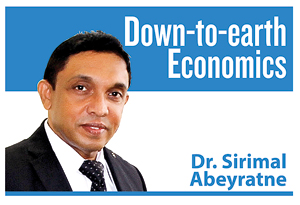Russian case of oily gold
View(s):
A Ukrainian child, who fled to Mexico amid the Russian invasion of his homeland, helps to unload a truck with pillows at the Benito Juarez sports complex, set up as a shelter by the local government, after arriving in Tijuana to enter the U.S., in Tijuana, Mexico April 7, 2022. REUTERS
Once, an amateur in the study of economics, asked me an intriguing question: “Sir, we like to have US dollars and other international currencies like Japanese yen, British pounds, and Euros! In the same way, why can’t people from other countries also opt to use Sri Lankan rupees?”
I responded with a question: “Why do they want Sri Lankan rupees? Not for the same reason as to why we want their currencies! Perhaps, they can give their kids our beautiful currency notes to paste on picture albums – right?”
As he started laughing, I said, “By the way, probably, we can ask our trading partner countries to pay us in Sri Lankan rupees, whenever they buy our exports! It might work because, then they must find rupees.”
Well, if you are confused, let me first elaborate the point before we proceed further. The point is that, other countries which need to buy Sri Lankan exports, should have Sri Lankan rupees. They can acquire
Sri Lankan rupees either by purchasing them from our banks (of course, we have plenty of rupees now) or by selling what they produce to Sri Lanka (as our imports) for rupees.
Either way, there will then be an international demand for Sri Lankan rupees, which would neutralize the fast-depreciating rupee as well. It has already depreciated against the US dollar by 50 per cent within a month, as the US dollar was Rs. 200 in early March, which is now going at over Rs. 300; it will continue further along the same downward path.
There is, however, one problem which would make the above claim utter nonsense; that is the lack of our own produce so demanded by the world! Therefore, who cares!
Gold and Ruble
After a long time, last week I recalled that conversation, because Russia announced exactly the same thing for its national currency – the Russian Ruble. Russia’s shocking moves in the international monetary system towards the end of last month, March 2022, were not discussed much in international business news.
Russia did two things, as stated by Pavel Zavalny, the head of the Russian Parliament in referring to the “unfriendly” Western countries which import Russian oil and gas: “If they want to buy, let them pay either in hard currency, and this is gold for us, or pay as it is convenient for us, this is the national currency”. This means that the Western countries should pay in either gold or ruble, if they want to buy Russian oil and gas.
Secondly, prior to the above notification, Russia fixed the price of gold at 5,000 ruble per gold gram. It is not clear whether both moves at the same time were a coincidence or accident. Whatever it is, if we take together both into account, it means that Russia’s oil and gas sales to the West have now been directly or indirectly tied to gold.
 In fact, gold was the world’s ‘international medium of exchange’ under the system of Gold Standards, until it was abandoned in 1944. As the Gold Standard was abandoned, the world moved into the fixed exchange rate system under which the countries must declare the value of their national currency against the US dollar – the fixed exchange rate. The US dollar, on the other hand was the currency, which was tied to gold, as the US continued to keep the largest gold stock in the world.
In fact, gold was the world’s ‘international medium of exchange’ under the system of Gold Standards, until it was abandoned in 1944. As the Gold Standard was abandoned, the world moved into the fixed exchange rate system under which the countries must declare the value of their national currency against the US dollar – the fixed exchange rate. The US dollar, on the other hand was the currency, which was tied to gold, as the US continued to keep the largest gold stock in the world.
But those few financial analysts who have noticed what Russia did, commented saying that it would be a blow to the current international monetary system dominated by the US dollar! And some have gone even beyond and above it, suspecting whether the world is returning to Gold Standards!
Of course, Russia’s silent move was shocking to the international financial system. But we don’t have enough evidence to jump into conclusions to say that it would be the end of the US dollar’s dominance in the world. It is quite safe to say that the US dollar hegemony is in a transition, but it is not because of Russia’s move. In fact, the rapidly growing bigger countries in Asia would alter the international monetary system in due time.
Western sanctions
Before Russia invaded Ukraine, the ruble was trading at about 80 rubles per US dollar; within two weeks after the Russian-Ukraine war broke out, it plummeted to over 130 rubles per dollar. The main cause was the Western sanctions on Russia’s trade with the West and the removal of Russian banks from the SWIFT system.
Russia is the third largest oil producer in the world after the US and Saudi Arabia, supplying 11 per cent of the world’s oil production. It is also the second largest gas producer in the world after the US and possesses the world’s largest gas deposit too. Thus, Russia’s major exports bear a significant influential position in the world.
Against the expected depreciation of the ruble and the downgraded credit rating to junk status, Russia’s bonds also made a sharp decline in prices and increase in interest rates. As the Russian invasion continued, the 10-year bond yield rose to over 14 per cent in the early days of the war.
Russia is the second largest gold-mining country in the world after China, producing nearly 10 per cent of the world’s gold production, while it also holds the fifth-largest gold reserves in the world. As the US and the European markets for Russian gold was closed due to sanctions, it had to find new avenues to sell its annual gold output worth US$20 billion.
As a strategy to keep the industry in operation, the Central Bank of Russia also resumed buying gold at a fixed price of 5,000 ruble per gram, and hence, international payments in either gold or ruble! By the way, the removal of Russian banks from the SWIFT system blocking its international payments doesn’t actually affect payments in gold or ruble.
At the same time, the Central Bank also more than doubled its policy rates to 20 per cent, which was less than 10 per cent in early February. With all new changes in place against Western sanctions, Russia has been able to achieve some stability too.
Future payments
Even though Russia is not a manufacturer which has the ability to sell its products to the world, the country is in an influential position in the world market. It’s because of its primary exports such as oil and gas, as well as wheat and other cereals, together with gold that can make an impact on the world commodity markets.
With its influential position in the world market, Russia has the ability to tell its buyers in the West to pay in either ruble or gold! If the strategy is by any means successful, it would increase international demand for ruble and Russian gold or Russian exports. And after all, ruble is also making its way to be an international currency in the future.
But the irony is that the Russian position in the world economy is too small to wipe out the value of the US dollar as an international reserve currency. Russia is nowhere near the influential economies in the world such as the US, the EU, China, Japan, and the UK, in terms of the size of the economy and the size of exports.
Even the international payments in gold does not mean that the world is returning to the pre-1944 Gold Standards; the world’s stock of gold reserves as well as its inelastic supply by the gold-mining countries including Russia is too small compared to the massive trade, investment and financial movements in the world.
There is no way for the return of the Gold Standards back to the international monetary system. By the way, if you have noticed a rapid increase in gold prices during the past two months, the Western sanctions against Russian gold trade have also played its part for that.
(The writer is a Professor of Economics at the University of Colombo and can be reached
at sirimal@econ.cmb.ac.lk and follow on Twitter @SirimalAshoka).
Hitad.lk has you covered with quality used or brand new cars for sale that are budget friendly yet reliable! Now is the time to sell your old ride for something more attractive to today's modern automotive market demands. Browse through our selection of affordable options now on Hitad.lk before deciding on what will work best for you!


